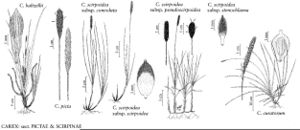Difference between revisions of "Carex scirpoidea subsp. convoluta"
Novon 7: 355. 1998.
FNA>Volume Importer |
imported>Volume Importer |
||
| Line 6: | Line 6: | ||
|place=7: 355. 1998 | |place=7: 355. 1998 | ||
|year=1998 | |year=1998 | ||
| + | }} | ||
| + | |special_status={{Treatment/ID/Special_status | ||
| + | |code=F | ||
| + | |label=Illustrated | ||
| + | }}{{Treatment/ID/Special_status | ||
| + | |code=E | ||
| + | |label=Endemic | ||
}} | }} | ||
|basionyms={{Treatment/ID/Basionym | |basionyms={{Treatment/ID/Basionym | ||
| Line 51: | Line 58: | ||
|publication title=Novon | |publication title=Novon | ||
|publication year=1998 | |publication year=1998 | ||
| − | |special status= | + | |special status=Illustrated;Endemic |
| − | |source xml=https:// | + | |source xml=https://bibilujan@bitbucket.org/aafc-mbb/fna-data-curation.git/src/bb6b7e3a7de7d3b7888a1ad48c7fd8f5c722d8d6/coarse_grained_fna_xml/V23/V23_1045.xml |
|genus=Carex | |genus=Carex | ||
|section=Carex sect. Scirpinae | |section=Carex sect. Scirpinae | ||
Revision as of 22:30, 27 May 2020
Plants cespitose; rhizomes inconspicuous. Culms erect, (9.2–) 19.5–35(–38) cm. Leaves: sheaths and bases from previous year’s leaves absent; blades narrowly V-shaped in cross section, to 23 cm × 1.8 mm, widest leaves of pistillate culm less than 1.5 mm wide. Scales ovate, 2.4 × 1.2 mm. Perigynia ovate, 1.5–2.6 × 1–1.2 mm, less than or equal to 2.5 times long as wide, body tightly enveloping achene for entire length and width. Achenes 1–1.5 × 0.6–0.9 mm.
Phenology: Fruiting early Jun–Sep.
Habitat: Prairie pavement barrens
Elevation: 200 m
Discussion
Carex scirpoidea subsp. convoluta is the most geographically restricted of the subspecies and is distinguished by narrowly V-shaped leaves, especially of the flowering shoot, a strongly cespitose habit, and conspicuously more flowering shoots per plant than other subspecies.
Selected References
None.

